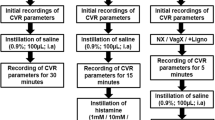Conclusions
-
1.
The striking similarities between neurogenic inflammation and antidromic vasodilatation in man an pig offers a reliable model for pharmacological investigations of mechanisms responsible for these actions.
-
2.
Apart from primates, pig skin appears to be the only animal model which allows investigations of the axon reflex.
-
3.
Vasodilation induced by antidromic electrical stimulation is obviously limited by the amount of mediator(s) e.g. substance P and calcitonin gene related peptide, available at the afferent nerve endings. A transient exhaustion of the mediator(s) is probably responsible for the reduction or total disappearance of antidromic vasodilatation, but the effect appears to be restored by axonal transport of the mediator(s).
Similar content being viewed by others
Author information
Authors and Affiliations
Rights and permissions
About this article
Cite this article
Pierau, F.K., Szolcsányi, J. Neurogenic inflammation: Axon reflex in pigs. Agents and Actions 26, 231–232 (1989). https://doi.org/10.1007/BF02126621
Issue Date:
DOI: https://doi.org/10.1007/BF02126621




